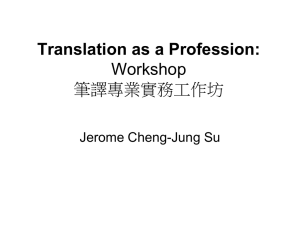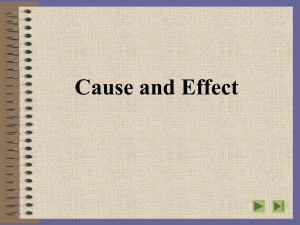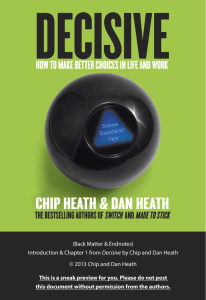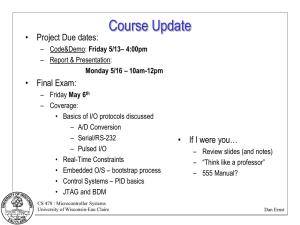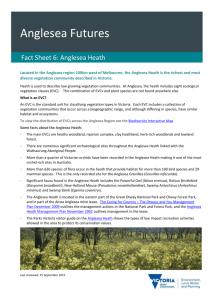(PPTX, Unknown)
advertisement
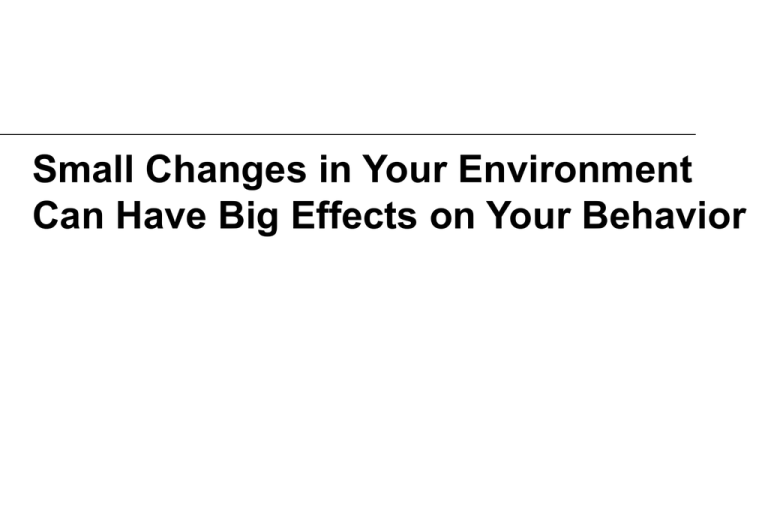
Small Changes in Your Environment Can Have Big Effects on Your Behavior Environmental changes are the low hanging fruit of behavior change • It’s far easier to change people’s environment than it is to change their mind • What looks like a “people” problem is often just an “environment” or “situation” problem 2 Broken windows theory 3 Keez Keiser confirmed this theory through a series of real world experiments • When graffiti was present, the proportion of litterers more than doubled from 33% to 69% Keizer, K.; Lindenderg, S.; Steg, L. The spreading of disorder. Science 2008, 322, 1681-1685. 4 Second experiment • When the first sign was disregarded, 82% (more than three times as many people), disregarded the second sign Keizer, K.; Lindenderg, S.; Steg, L. The spreading of disorder. Science 2008, 322, 1681-1685. 5 Third experiment • When the the mailbox was covered with graffiti the proportion of thieves more than doubled to 27% Keizer, K.; Lindenderg, S.; Steg, L. The spreading of disorder. Science 2008, 322, 1681-1685. 6 Take away • Small changes in our environment can have a big impact on our behavior 7 So how can leverage this finding? 1. Tweaking the environment • Make the desired task easier to complete 9 Amazon does this through its One-click ordering feature 10 Morning exercise people do this by laying out there workout clothes before they go to bed 11 Charities do this by placing donation drops in high traffic areas 12 Nurses do this by wearing red vests to discourage interruptions during medication deliveries 13 Dieters do this by shifting from family size bags to single serve packaging 14 Governments do this by making organ donation the default option 15 High school cafeterias are doing this by displaying healthy foods more prominently 16 So how big can these small environmental changes be? Tweaking a College Food Donation Campaign All Students Profiling Survey Givers Switch by Chip and Dan Heath, 2010 Non-Givers They Prepared 2 Different Donation Letters Basic Letter • Announced the launch of food drive the following week • Asked them bring canned food to a booth in a well known place on campus • • • • Switch by Chip and Dan Heath, 2010 More Detailed Letter Announced the launch of food drive the following week Included a map to the precise spot on campus where booth would be Requested cans of beans specifically Suggested that they plan a time when they will be near booth so drop off will be easy Tweaking a College Food Donation Campaign All Students Profiling Survey Givers Detail Donation Rate 42% Non-Givers Basic Detail Basic 8% 25% 0% 3X What looks like a people problem is often an environment or situation problem Switch by Chip and Dan Heath, 2010 2. Setting action triggers • Create a mental plan of action that gets triggered when a cue is present Switch by Chip and Dan Heath, 2010 21 Research shows that action triggers are most useful in difficult situations • In one study of patients recovering from hip- or knee surgery, one group was asked to set action triggers • Individuals were asked to write down when they would take their walks and where they planned to go on those walks • On average, the action trigger patients were bathing themselves without assistance in 3 weeks versus 7 weeks • Action trigger patients were standing up in 3.5 weeks versus 7.7 weeks • In just 1 month, the action trigger patients were getting into and out of cars on their own versus 2.5 months for patients in the other group 22 Switch by Chip and Dan Heath, 2010 And while action triggers aren’t foolproof, it’s hard to find an easier way to drive change • A recent meta-study that analyzed 8,155 participants across 85 studies found that the typical person who set an action trigger did better than 74% of people on the same task who didn’t set one Switch by Chip and Dan Heath, 2010 23 Checklists are slightly more detailed forms of action triggers • The Story of Dr. Peter Pronovost – ICU physician at Johns Hopkins – Mission: Reduce IV line infections in ICUs – Challenge: No direct authority over his colleagues Switch by Chip and Dan Heath, 2010 24 So he began by studying the literature on IV line infections • The medical literature confirmed 5 major sources of line infections • Studies in other hospitals confirmed that reductions in any of these 5 indicators resulted in reductions in IV line infections • Peter drafted a 5 step checklist • Published his checklist in a leading medical journal Switch by Chip and Dan Heath, 2010 Peter’s Checklist 1. Wash your hands before inserting a line 2. Clean patient’s skin with antiseptic at the point of insertion 3. Put sterile drapes over the entire patient 4. Wear a sterile mask, hat, gown, and gloves 5. Put sterile dressing over the catheter site once the line is in Source: New Yorker Magazine; December 10, 2007 Peter’s initial test at JHU was a major success • Peter decides to test the checklist in more challenging environment • He works with state of Michigan to implement the checklist at all state managed hospitals • State managed hospitals were among the lowest performing hospitals with the worst reputation for quality and outcomes Source: New Yorker Magazine; December 10, 2007 The Results speak for themselves • Peter’s checklist implemented in Michigan ICUs over 18 months • ICU line infections declined to almost zero • The checklist saved approximately 1,500 lives • The reduction in line infections reduced costs by $175 million Source: New Yorker Magazine; December 10, 2007 Summary • Environmental changes are the low hanging fruit of behavior change because it’s far easier to change people’s environment than it is to change their mind • In fact, what looks like a “people” problem is often just an “environment” or “situation” problem • By making small changes in our environment we can have a big impact on behavior – Tweaking the environment you’re trying to change – Setting action triggers to preload important decisions 29



